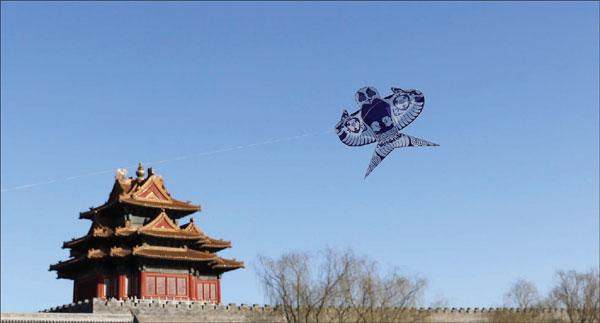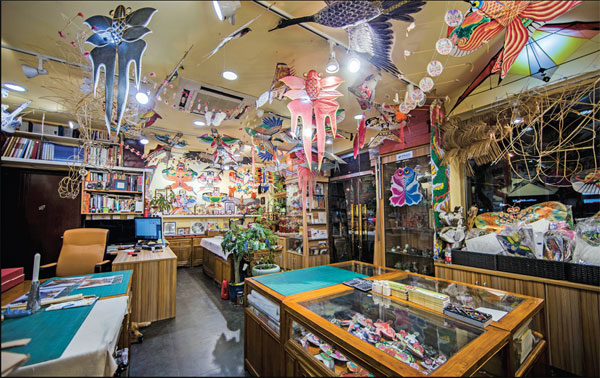

Craftsman's expertise has turned traditional soaring masterpieces into airborne works of art
Liu Bin, who owns a small kite shop in downtown Beijing, says his kites, all of which cost more than 200 yuan ($29; 27 euros; £22), or about 10 times the price of his online rivals, deserve their higher price tags.
"A kite is more than a flying toy. It is made with rich Chinese culture and a craftsman's wisdom," he says, adding it takes about 20 days to make a kite.
Most of the kites that decorate his shop, in shapes including swallows, goldfish, dragons, the Monkey King and Peking Opera masks, are handmade. Some are tiny enough to fit in the palm of your hand; others cover an entire wall.
Kite flying, which has a history of more than 2,000 years in China, is thought to have begun as a means of passing military information in war. It gradually became a popular folk pastime in springtime.
His great-grandfather was a craftsman in the Forbidden City in the late Qing Dynasty (1644-1911) and was in charge of making lanterns, fans and kites. Liu recalls the day his grandfather flew a 130-meter-long dragon kite train in Tian'anmen Square in 1982. Liu, then 5, watched as people thronged to the square, cheering the flying "dragon".
Liu assembled his first kite at age 10. His parents found he had a flair for designing and crafting kites, so they decided to cultivate him as an inheritor.
"I want to elevate the kite from a toy to a work of art," he says.
For China Daily

Kite flying has a history of more than 2,000 years in China. Photos by Liu Bin / For China Daily

Liu Bin's kite shop, San Shi Zhai Kites (Three-Stone Studio), at Di'anmen street in downtown Beijing.
 Fire brigade in Shanghai holds group wedding
Fire brigade in Shanghai holds group wedding Tourists enjoy ice sculptures in Datan Town, north China
Tourists enjoy ice sculptures in Datan Town, north China Sunset scenery of Dayan Pagoda in Xi'an
Sunset scenery of Dayan Pagoda in Xi'an Tourists have fun at scenic spot in Nanlong Town, NW China
Tourists have fun at scenic spot in Nanlong Town, NW China Harbin attracts tourists by making best use of ice in winter
Harbin attracts tourists by making best use of ice in winter In pics: FIS Alpine Ski Women's World Cup Slalom
In pics: FIS Alpine Ski Women's World Cup Slalom Black-necked cranes rest at reservoir in Lhunzhub County, Lhasa
Black-necked cranes rest at reservoir in Lhunzhub County, Lhasa China's FAST telescope will be available to foreign scientists in April
China's FAST telescope will be available to foreign scientists in April "She power" plays indispensable role in poverty alleviation
"She power" plays indispensable role in poverty alleviation Top 10 world news events of People's Daily in 2020
Top 10 world news events of People's Daily in 2020 Top 10 China news events of People's Daily in 2020
Top 10 China news events of People's Daily in 2020 Top 10 media buzzwords of 2020
Top 10 media buzzwords of 2020 Year-ender:10 major tourism stories of 2020
Year-ender:10 major tourism stories of 2020 No interference in Venezuelan issues
No interference in Venezuelan issues
 Biz prepares for trade spat
Biz prepares for trade spat
 Broadcasting Continent
Broadcasting Continent Australia wins Chinese CEOs as US loses
Australia wins Chinese CEOs as US loses